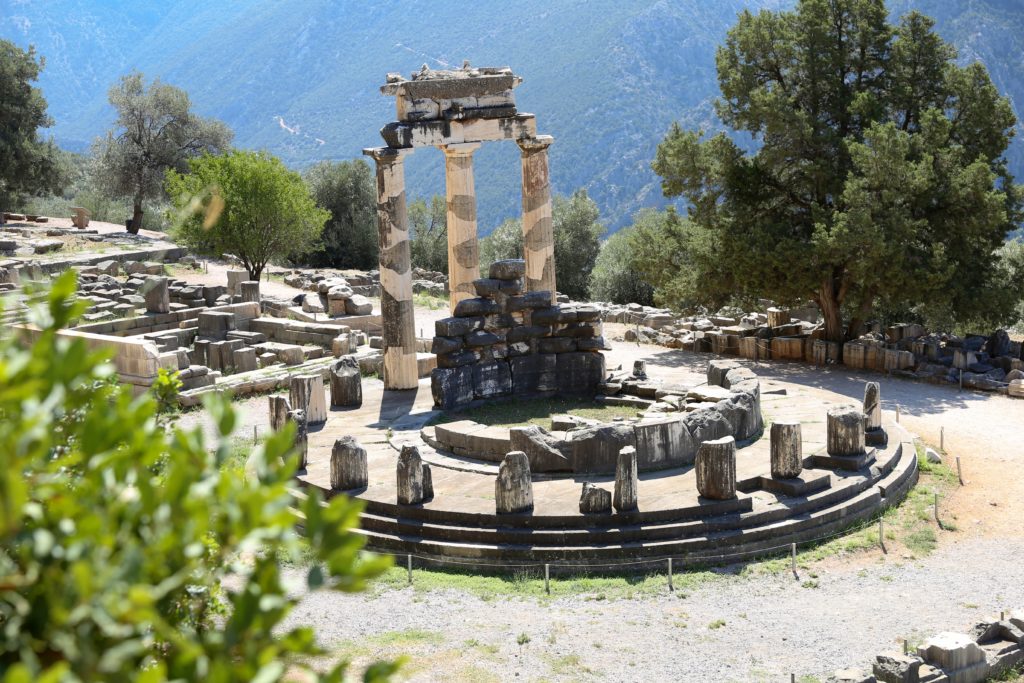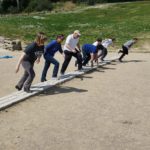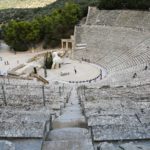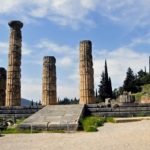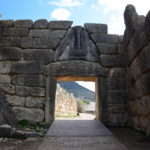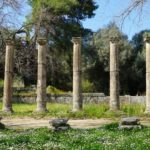3 days
Private Tour
English
Up to 12 Guests
3 Days Private Tour: Mycenae-Epidaurus-Corinth-Olympia & Delphi
Got a Question?
Contact UsHighlights
Ancient Greek Cities private tour
1st Day:
- Corinth Canal
- Ancient Corinth – Temple of Apollo
- Epidaurus
- Mycenae
- The picturesque town of Nafplio – Bourtzi
Overnight: Olympia
2nd Day:
- Ancient Olympia – Archaeological Museum Olympia
- Rio – Antirio Bridge
- Arachova – Village of Delphi
Overnight: Delphi
3rd Day:
- The Oracle of Delphi – Museum of Delphi
- Sanctuary Athena Pronea – Gymnasium
- Hosios Loukas Monastery
- Drive to Athens
Itinerary
1st Day:
This tour gives you the opportunity to enjoy the real Greece through the country villages and at the same time to visit three of the most important ancient Greek sanctuaries, Ancient Olympia, Delphi, Epidaurus.
The tour begins with a drive to the Corinth Canal following the coast of the western suburbs of Athens through Olympia highway. On the way, you will have a view of some Greek villages by the sea and the island of Salamis (where the historical naval battle was held between the Athenians and Persians 480 BCE). Our first stop is going to be the Corinth Canal. Opened in 1892 separating the Peloponnese peninsula from the rest of Greece and connecting the Saronic Gulf to the Corinthian Sea. You will have time to walk across on a pedestrian bridge to admire the canal closer, (if you’re game,) on some days bungee jumping is an option.
Moving on we will make our way to Ancient Corinth. This ancient city was dominated by the hill of Acrocorinth and the old Castle, the biggest and oldest castle in southern Greece. Ancient Corinth is located at the foot of the hill and includes the Roman Agora of Corinth, the temple of God Apollo and a small museum. Away from its archaeological and historical interest Ancient Corinth is also one of the most popular religious destinations in Greece. This was where the Apostle Paul preached Christianity, was judged by the tribunal in the Agora and established the best organized Christian church of that period.
Driving along the eastern coast of the Peloponnese peninsula we will reach Ancient Epidaurus and the sanctuary of God Asclepius, the God of Medicine, located in a peaceful environment and the best-preserved ancient Greek theater dated 4th century BCE. Proof of what miracles the ancient Greek minds could create. You can test the acoustics, great, even today and climb up to the upper seats just to close your eyes and dream you attended an ancient Greek tragedy.
Continuing our way after a short drive we will reach Mycenae, the site that changed everything we thought we knew about of Mycenae, dated back to the 2nd Millennium BCE and representing the era of Achilles, Agamemnon, and Helen of Troy. In the site, you will see the renowned Lions Gate (the oldest architectural sculpture in Europe), the cyclopean walls, the burial circle A and the remains of Agamemnon’s Palace. Within the site, there is a modern museum exhibiting the findings of the “City Of Gold” before leaving the site we will make a small stop at the treasury of Atreus, the best preserved Tholos tomb, one of the finest examples of the Mycenaean architecture.
After that, we will travel towards a more recent history of Greece to the city of Nafplion considered the most scenic city which functioned as the capital of Greece until 1834. It offers you an outstanding combination of fortresses and castle (Palamidi), Bourtzi, a huge port opened to the Aegean Sea and the unique architecture of the old city of Nafplion revealing Venetian, neoclassical and oriental elements. After walking in the idyllic old city we will stop for lunch at a traditional tavern by the sea, and drive up until the castle of Acronafplia for a panoramic view of Nafplio.
Our last drive for the day will be towards Ancient Olympia driving by the cities of Tripoli and Megalopoli finally reaching the western coast opened towards the Ionia Sea. At Ancient Olympia we will stop at a hotel and you will have the time to enjoy the small village in the evening.
2nd Day:
The following day, we will visit the archaeological site and the museum of Ancient Olympia. One of the largest sites in Greece, the birthplace of the Olympic Games and the Sanctuary of Olympian
Zeus. Walking in the site you will pass by the Gymnasium, the Palaistra, the workshop of Phidias, the Temple of Zeus and you will end up at the Stadium where every four years the Greeks were competing for glory and for spiritual elevation, honoring their cities. The museum is also unique as it includes the renowned statue “Hermes of Praxiteles” with its perfect analogies and tools that belonged to Phidias himself. With these tools, he managed to create one of the seven wonders of the world “the gold ivory statue of Zeus”.
After the site we will head towards Delphi, driving by the port of Patra (the western Capital of Greece), we will reach the bridge (Charilaos Trikoupis) of Rio – Antirio that connects Peloponnese peninsula to the Greek mainland. Considered a miracle of engineering this bridge is one of the world’s longest multi-span cable-stayed bridges and the longest of the fully suspended type. Crossing the bridge we will find Nafpaktos a small town by the sea where we will make a small stop for our lunch at a traditional Greek tavern having a view towards the battlefield where the naval battle of Lepanto took place in 1571, between the Ottoman Empire and the united western powers. Following we will drive up the slopes of mountain Parnassus, on our way you will have the opportunity to see the huge valley of olive trees representing the Greek olive sea. Passing through the village of Delphi we will stop at the mountainous village of Arachova to spend the night. Arachova is very close to a ski resort, full of traditional houses and shops selling locally produced products. You can walk through the village with its narrow streets and shops on the central street having a breathtaking view of the mountains full of olive trees literally in front of you.
3rd Day:
After spending the night at Arachova we will have a short drive to Delphi in order to visit the archeological museum of Delphi and the site. Delphi is an ancient Greek sanctuary with a catholic character dedicated to God Apollo. It functioned as an Oracle and was considered ‘the naval’ the center of the world and is today a symbol of Greek cultural unity. The scenic location allows you to have a view of the Greek mountains and two more sites the Gymnasium and the secondary sanctuary of Athena Pronea. In the site, you will visit the Temple of Apollo where Pythia spoke to the oracles, the theater, and the stadium. While in the museum you will be able to see the famous charioteer and Gold Ivory statues. After the site, we will have our lunch at the modern village of Delphi with a view of the mountains of Fokis. Our trip will continue to Hosios Loukas monastery a site of Greece’ Medieval period which represents the second golden age of Byzantine art (11th -12th century) in particular its golden mosaic decoration and fine architecture. After spending some time in this area of serenity we will make our last stop at the town of Livadia for a Greek dinner and walk by the Krya springs. Following through we will return back to Athens.
Inclusions - Exclusions
Private Tours are personal and flexible just for you and your party.
Inclusions:
- Professional Drivers with Deep knowledge of history. [Not licensed to accompany you in any site.]
- Accommodation and breakfast (according to your booking)
- Hotel/ AirBnb/ Port pickup and drop-off
- Bottled water
- Guaranteed to skip the long lines / Tickets are NOT included.
Exclusions:
- Entrance Fees
- Licensed Tour guide on request (Additional cost)
- Accommodation and breakfast (according to your booking)
- Personal expenses (drinks, meals, etc.)
- Airport Pick Up and drop-off (Additional cost)
Entrance Fees
ADMISSION FEES FOR SITES:
Summer Period: 105€ per person
(1 April – 31 October)
Ancient Corinth: 15€ (08:00- 20:00)
Mycenae: 20€ (08:00- 20:00)
Epidaurus: 20€ (08:00- 20:00)
Ancient Olympia: 20€ (08:00- 20:00)
Delphi: 20€ (08:00- 20:00)
Hosios Loukas Monastery: 10€ (08:00- 15:30)
Winter Period: 105€ per person
(1 November – 31 March)
Ancient Corinth: 15€ (08:00- 15:30)
Mycenae: 20€ (08:00- 15:30)
Epidaurus: 20€ (08:00- 15:30)
Ancient Olympia: 20€ (08:00- 15:00)
Delphi: 20€ (08:00- 15:30)
Hosios Loukas Monastery: 10€ (08:00- 15:30)
Free admission days:
- 6 March (in memory of Melina Mercouri)
- 18 April (International Monuments Day)
- 18 May (International Museums Day)
- The last weekend of September annually (European Heritage Days)
- Every first and third Sunday from November 1st to March 31st
- 28 October
Holidays:
- 1 January: closed
- 25 March: closed
- 1 May: closed
- Easter Sunday: closed
- 25 December: closed
- 26 December: closed
Free admission for:
- Children & young people up to the age of 25 from EU Member- States
- Children & young people from up to the age of 18 from Non- European Union countries
- Persons over 25 years, being in secondary education & vocational schools from EU Member- States
- Escorting teachers during the visits of schools & institutions of Primary, Secondary & Tertiary education from EU Member- States
- People entitled to Social Solidarity income & members depending on them
- Persons with disabilities & one escort (only in the case of 67% disability)
- Refugees
- Official guests of the Greek State
- Members of ICOM & ICOMOS
- Members of societies & Associations of friends of State Museums & Archaeological sites
- Scientists licensed for photographing, studying, designing or publishing antiquities
- Journalists
- Holders of a 3- year Free Entry Pass
Reduced admission for:
- Senior citizens over 65 from Greece or other EU member-states, during
the period from 1st of October to 31st of May - Parents accompanying primary education schools visits from EU Member- States
- Escorting teachers of educational visits of schools & institutions of primary, secondary & tertiary education from non European Union countries
Reduced & free entrance only upon presentation of the required documents
History
Corinth Canal:
The famous Corinth Canal connects the Gulf of Corinth with the Saronic Gulf in the Aegean Sea. It cuts through the narrow Isthmus of Corinth and separates the Peloponnesian peninsula from the Greek mainland, thus effectively making the former an island. The canal is 6.4 kilometers in length and only 21.3 meters wide at its base. Earth cliffs flanking either side of the canal reach a maximum height of 63 meters. Aside from a few modest-sized cruise ships, the Corinth Canal is unserviceable to most modern ships. The Corinth Canal, though only completed in the late 19th century, was an idea and dream that dates back over 2000 thousand years.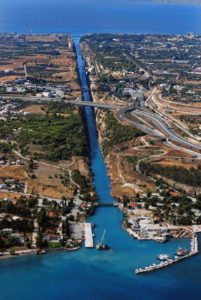
Before it was built, ships sailing between the Aegean and Adriatic had to circumnavigate the Peloponnese adding about 185 nautical miles to their journey. The first to decide to dig the Corinth Canal was Periander, the tyrant of Corinth (602 BCE). Such a giant project was above the technical capabilities of ancient times so Periander carried out another great project, the diolkós, a stone road, on which the ships were transferred on wheeled platforms from one sea to the other. Dimitrios Poliorkitis, king of Macedon (c. 300 BCE), was the second who tried, but his engineers insisted that if the seas where connected, the more northerly Adriatic, mistakenly thought to be higher, would flood the more southern Aegean. At the time, it was also thought that Poseidon, god of the sea, opposed joining the Aegean and the Adriatic. The same fear also stopped Julius Caesar and Emperors Hadrian and Caligula. The most serious try was that of Emperor Nero (67 CE). He had 6,000 slaves for the job. He started the work himself, digging with a golden hoe, while music was played. However, he was killed before the work could be completed.
In the modern era, the first who thought seriously to carry out the project was Kapodistrias (c. 1830), first governor of Greece after the liberation from the Ottoman Turks. But the budget, estimated at 40 million French francs, was too much for the Greek state. Finally, in 1869, the Parliament authorized the Government to grant a private company (Austrian General Etiene Tyrr) the privilege to construct the Canal of Corinth. Work began on Mar 29, 1882, but Tyrr’s capital of 30 million francs proved to be insufficient. The work was restarted in 1890, by a new Greek company (Andreas Syggros), with a capital of 5 million francs. The job was finally completed and regular use of the Canal started on Oct 28, 1893. Due to the canal’s narrowness, navigational problems and periodic closures to repair landslips from its steep walls, it failed to attract the level of traffic anticipated by its operators. It is now used mainly for tourist traffic. The bridge above is perfect for bungee jumping.
Ancient Corinth:
Located on the isthmus which connects mainland Greece with the Peloponnese, surrounded by fertile plains and blessed with natural springs, Corinth was an important city in Greek, Hellenistic, and Roman times. Its geographical location, role as a center of trade, naval fleet, participation in various Greek wars, and status as a major Roman colony meant the city was, for over a millennium, rarely out of the limelight in the ancient world.
CORINTH IN MYTHOLOGY
Not being a major Mycenaean center, Corinth lacks the mythological heritage of other Greek city-states. Nevertheless, the mythical founder of the city was believed to have been King Sisyphus, famed for his punishment in Hades where he was made to forever roll a large boulder up a hill. Sisyphus was succeeded by his son Glaucus and his grandson Bellerophon, whose winged-horse Pegasus became a symbol of the city and a feature of Corinthian coins. Corinth is also the setting for several other episodes from Greek mythology such as Theseus’ hunt for the wild boar, Jason settled there with Medea after his adventures looking for the Golden Fleece, and there is the myth of Arion – the real-life and gifted kithara player and resident of Corinth – who was rescued by dolphins after being abducted by pirates.
HISTORICAL OVERVIEW
The city was first inhabited in the Neolithic period (c. 5000 BCE) but became more densely populated from the 10th century BCE. The historical founders were the aristocratic descendants of King Bacchis, the Bacchiadae (c. 750 BCE). The Bacchiadae ruled as a body of 200 until in 657 BCE when the popular tyrant Cypselus took control of the city, to be succeeded by his son Periander (627-587 BCE). Cypselus funded the building of a treasury at Delphi and set up new colonies.
From the 8th century BCE, Corinthian pottery was exported across Greece. With its innovative figure decoration, it dominated the Greek pottery market until the 6th century BCE when Attic black-figure pottery took over as the dominant style. Other significant exports were Corinthian stone and bronze wares. Corinth also became the hub of trade through the diolkos. This was a stone track with carved grooves for wheeled wagons which offered a land short-cut between the two seas and probably dates to the reign of Periander. In the Peloponnesian War, the diolkos was even used to transport triremes. Although the idea for a canal across the isthmus was first considered in the 7th century BCE and various Roman Emperors from Julius Caesar to Hadrian began surveys, it was Nero who actually began the project (67 CE). However, on the emperor’s death, the project was abandoned, not to be resumed until 1881.
From the early 6th century BCE, Corinth administered the PanHellenic games at nearby Isthmia, held every two years in the spring. These games were established in honor of Poseidon and were particularly famous for their horse and chariot races.
An oligarchy, consisting of a council of 80, gained power in Corinth (585 BCE). Concerned with the local rival, Argos, from 550 BCE Corinth became an ally of Sparta. During Cleomenes’ reign though, the city became wary of the growing power of Sparta and opposed Spartan intervention in Athens. Corinth also fought in the Persian Wars against the invading forces of Xerxes which threatened the autonomy of all of Greece.
Corinth suffered badly in the First Peloponnesian War, which it was responsible for after attacking Megara. Later it was also guilty of causing the Second Peloponnesian War, in 433 BCE. Once again though, the Corinthians, mainly as Sparta’s naval ally, had a disastrous war. Disillusioned with Sparta and concerned over Spartan expansion in Greece and Asia Minor, Corinth formed an alliance with Argos, Boeotia, Thebes, and Athens to fight Sparta in the Corinthian Wars (395 – 386 BCE). The conflict was largely fought at sea and on Corinthian territory and was yet another costly endeavor for the citizens of Corinth.
Corinth became the seat of the Corinthian League, but losing a war against Philip II of Macedon (338 BCE) this ‘honor’ was a Macedonian garrison being stationed on the Acrocorinth acropolis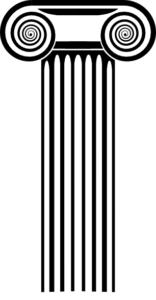 overlooking the city.
overlooking the city.
A succession of Hellenistic kings took control of the city – starting with Ptolemy I and ending with Aratus in 243 BCE when Corinth joined the Achaean League. However, the worst was yet to come when the Roman commander Lucius Mummius sacked the city (146 BCE).
A brighter period was when Julius Caesar took charge (in 44 BCE) and organized the agricultural land into organized plots (centuriation) for distribution to Roman settlers. The city once more flourished, by the 1st century CE it became an important administrative and trade center again. In addition, following St. Paul’s visit between 51 and 52 CE, Corinth became the center of early Christianity in Greece. In a public hearing, the saint had to defend himself against accusations from the city’s Hebrews that his preaching undermined the Mosiac Law. The pro-consul Lucius Julius Gallio judged that Paul had not broken any Roman law and so was permitted to continue his teachings. From the 3rd century, CE Corinth began to decline and the Germanic tribes attacked the city.
THE ARCHAEOLOGICAL SITE
In Greek Corinth, there were cults to Aphrodite (protector of the city), Apollo, Demeter Thesmophoros, Hera, Poseidon, and Helios and various buildings to cult heroes, the founders of the city. In addition, there were several sacred springs, the most famous being Peirene. Unfortunately, the destruction in 146 BCE erased much of this religious past. In Roman Corinth, Aphrodite, Poseidon, and Demeter did continue to be worshipped along with the Roman gods.
The site today, first excavated in 1892 CE by the Greek Archaeological Service, is dominated by the Doric peripteral Temple of Apollo (550-530 BCE), originally with 6 columns on the façades and fifteen on the long sides. A particular feature of the temple is the use of monolithic columns rather than the more commonly used column drums. Seven columns remain standing today.
The majority of the other surviving buildings date from the 1st century CE in the Roman era and include a large forum, a temple to Octavia, baths, the Bema where St. Paul addressed the Corinthians, the Asklepeion temple to Asclepius, and a centre of healing, fountains – including the monumental Peirine fountain complex (2nd century CE) – a propylaea, theatre, odeion, gymnasium, and stoas. There are also the remains of three basilicas.
Archaeological finds at the site include many fine mosaics – notably the Dionysos mosaic – Greek and Roman sculpture – including an impressive number of busts of Roman rulers.
Epidaurus:
Located on the fertile Argolid plain of the east Peloponnese in Greece and blessed with a mild climate and natural springs, the sanctuary of Asclepius at Epidaurus was an important sacred center in both ancient Greek and Roman times.
Epidaurus was named after the hero Epidauros, son of Apollo. Inhabited since Neolithic times, the first significant settlement was in the Mycenaean period. Fortifications, a theatre and tholos tombs have been excavated dating as early as the 15th century BCE, although it was in the 12th century BCE that Epidaurus Limera, with its harbor linking it to the Aegean trade network, particularly flourished.
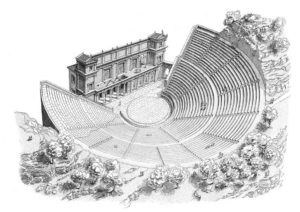 Earlier regional worship of the deity Maleatas evolved into the later worship of Apollo, who was given similar attributes. However, it was Asclepius (also spelt Asklepios), whom the Epidaurians believed was born on the nearby Mt. Titthion, who took precedence from the 5th century BCE until Roman times in the 4th century CE. Credited with possessing great healing powers (learnt from his father Apollo) and also those of prophecy, the god – as manifested in the sanctuary or Asklepieion – was visited from all over Greece by those seeking ease and remedies from their illnesses either by divine intervention or medicines administered by the priests. The sanctuary used the wealth gained from dedications of the worshipers to build an impressive complex of buildings and to sponsor major art projects to beautify the center. Indeed, many of the offerings given were works of art such as statues, pottery vessels, tripods, and even buildings.
Earlier regional worship of the deity Maleatas evolved into the later worship of Apollo, who was given similar attributes. However, it was Asclepius (also spelt Asklepios), whom the Epidaurians believed was born on the nearby Mt. Titthion, who took precedence from the 5th century BCE until Roman times in the 4th century CE. Credited with possessing great healing powers (learnt from his father Apollo) and also those of prophecy, the god – as manifested in the sanctuary or Asklepieion – was visited from all over Greece by those seeking ease and remedies from their illnesses either by divine intervention or medicines administered by the priests. The sanctuary used the wealth gained from dedications of the worshipers to build an impressive complex of buildings and to sponsor major art projects to beautify the center. Indeed, many of the offerings given were works of art such as statues, pottery vessels, tripods, and even buildings.
At the height of the site’s importance in the 4th century BCE (370-250 BCE), major buildings included two monumental entrances (Propylaia); a large temple (380-375 BCE) with the typical 6×11 column Doric layout, containing a larger than life-size Chryselephantine statue of a seated Asclepius (by Thrasymedes) and with pediments displaying in statuary the Amazonomachy and the Siege of Troy; temples dedicated to Aphrodite (320 BCE), Artemis and Themis; a sacred fountain; the Thymele (360-330 BCE) – around marble building originally with 26 outer Doric columns, a 14 Corinthian columned cella and a mysterious underground labyrinth, perhaps containing snakes which were associated with Asclepius; the columned Abato (or Enkoimeterion) in which patients waited overnight for divine intervention and remedy; other temples, hot and cold bathhouses, stoas, stadium, palaistra and large gymnasium; and a 6000 seat theatre (340-330 BCE). These latter sporting and artistic buildings were used in the Asklepieia festival, founded in the 5th century BCE and held every four years to celebrate theatre, sport, and music. The theatre, with 2nd century CE additions resulting in 55 tiers of seats and a capacity of perhaps 12,300 spectators, would become one of, if not the, largest theatres in antiquity. Other Roman additions to the site in the 2nd century included a temple of Hygieia, a large bath building and a small odeum.
The site was destroyed in 395 CE by the Goths and the Emperor Theodosius II definitively closed the site along with all other pagan sanctuaries in 426 CE. The site was abandoned once and for all following earthquakes in 522 and 551 CE. Excavations at the ancient site were first begun in 1881 CE by the Greek Archaeological Society and continue to the present day. Today, the magnificent theatre, renowned for its acoustics, is still in active use for performances in an annual traditional theatre festival.
Mycenae:
Mycenae was a fortified late Bronze Age city located between two hills on the Argolis plain of the Peloponnese, Greece. The acropolis today dates from between the 14th and 13th century BCE when the Mycenaean civilization was at its peak of power, influence and artistic expression.
IN MYTHOLOGY:
In Greek mythology, the city was founded by Perseus, who gave the site its name either after his sword’s scabbard (mykes) fell to the ground and was regarded as a good omen or as he found a water spring near a mushroom (mykes). Perseus was the first king of the Perseid dynasty which ended with Eurytheus (instigator of Hercules’ famous twelve labours). The succeeding dynasty was the Atreids, whose first king, Atreus, is traditionally believed to have reigned around 1250 BCE. Atreus’ son Agamemnon is believed to have been not only king of Mycenae but of all of the Achaean Greeks and the leader of their expedition to Troy to recapture Helen. In Homer’s account of the Trojan War in the Iliad, Mycenae (or Mykene) is described as a ‘well-founded citadel’, as ‘wide-wayed’ and as ‘golden Mycenae’, the latter supported by the recovery of over 15 kilograms of gold objects recovered from the shaft graves in the acropolis.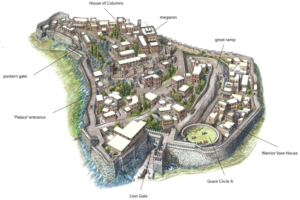
HISTORICAL OVERVIEW:
Situated on a rocky hill (40-50 m high) commanding the surrounding plain as far as the sea 15 km away, the site of Mycenae covered 30,000 square meters and has always been known throughout history. First excavations were begun by the Archaeological Society of Athens in 1841 and then continued by the famous Heinrich Schliemann in 1876 that discovered the magnificent treasures of Grave Circle A. The archaeological excavations have shown that the city has a much older history than traditional Greek literature described.
Even though the site was inhabited since Neolithic times, it is not until 2100 BCE that the first walls, pottery finds (including imports from the Cycladic islands) and pit and shaft graves with higher quality grave goods appear. These, collectively, suggest greater importance and prosperity in the settlement.
Since 1600 BCE there is evidence of an elite presence on the acropolis: high-quality pottery, wall paintings, shaft graves and an increase in the surrounding settlement with the construction of large tholos tombs. From the 14th century BCE the first large-scale palace complex is built (on three artificial terraces), so is the celebrated tholos tomb, the Treasury of Atreus, a monumental circular building with corbelled roof reaching a height of 13.5 m and 14.6 m in diameter and approached by a long walled and unroofed corridor 36 m long and 6m wide. Fortification walls, of large roughly worked stone blocks, surrounding the acropolis (of which the north wall is still visible today), flood management structures such as dams, roads, Linear B tablets and an increase in pottery imports (fitting well with theories of contemporary Mycenaean expansion in the Aegean) illustrate the culture was at its zenith.
ARCHITECTURE:
The large palace structure built around a central hall or Megaron is typical of Mycenaean palaces. Other features included a secondary hall, many private rooms, and a workshop complex. Decorated stonework and frescoes and a monumental entrance, the Lion Gate (a 3 m x 3 m square doorway with an 18-ton lintel topped by two 3 m high heraldic lions and a column altar), added to the overall splendor of the complex. The relationship between the palace and the surrounding settlement and between Mycenae and other towns in the Peloponnese is much discussed by scholars. Concrete archaeological evidence is lacking but it seems likely that the palace was a center of political, religious and commercial power. Certainly, high-value grave goods, administrative tablets, pottery imports and the presence of precious materials deposits such as bronze, gold, and ivory would suggest that the palace was, at the very least, the hub of a thriving trade network.
The first palace was destroyed in the late 13th century, probably by earthquake and then (rather poorly) repaired. A monumental staircase, the North Gate, and a ramp were added to the acropolis and the walls were extended to include the Perseia spring within the fortifications. The spring was named after the city’s mythological founder and was reached by an impressive corbelled tunnel (or syrinx) with 86 steps leading down 18m to the water source. It is argued by some scholars that these architectural additions are evidence for a preoccupation with security and possible invasion. This second palace was also destroyed, this time with signs of fire. Some rebuilding did occur and pottery finds suggest a degree of prosperity returned briefly before another fire ended occupation of the site until a brief revival in Hellenistic times. With the decline of Mycenae, Argos became the dominant power in the region. Reasons for the demise of Mycenae and the Mycenaean civilization are much debated with suggestions including natural disaster, over-population, internal social and political unrest or invasion from foreign tribes.
Nafplio:
The city of Nafplio was the first capital of the modern Greek state. Named after Nafplios, son of Poseidon, and home of Palamidis, their local hero of the Trojan war and supposedly the inventor of weights and measures, lighthouses, the first Greek alphabet and the father of the Sophists. The small city-state made the mistake of allying with Sparta in the second Messenian War (685 – 688 BC) and was destroyed by Damokratis the king of Argos.
Because of the strength of the fort that sits above the bay, the town of Nafplio became an important strategic and commercial center to the Byzantines from around the sixth century AD. In 1203 Leon Sgouros, ruler of the city, conquered Argos and Corinth, and Larissa to the north, though it failed to successfully conquer Athens after a siege in 1204.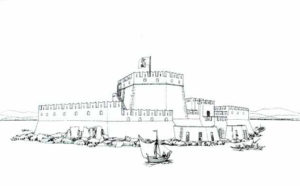
With the fall of Constantinople to the Turks, the Franks, with the help of the Venetians captured the city and nearly destroyed the fortress in the process. In the treaty, the defenders of the city were given the eastern side of the city, called Romeiko and allowed to follow their customs, while the Franks controlled the Akronafplia, which was most of the city at the time. The Franks controlled the city for 200 years and then sold it to the Venetians. The Venetians continued the fortification of the upper town and completed their work in 1470. That same year they built a fort on the small island in the center of the harbor called the Bourtzi. To close the harbor the fort was linked by chains and the town was known as Porto Cadenza, meaning Port of Chains. During this period people flocked to the safety of the fortified city in fear of the Turks and forced the expansion of the city into the lagoon between the sea and the walls of the Akronafplia. The new additions to the city were surrounded with walls and many major buildings were erected including the Church of Saint George. But these new walls didn’t matter because in the treaty with Suleiman the First, Nafplio was handed over to the Turks who controlled the city for 100 years and made it the primary import/export center for mainland Greece.
In 1686 the Turks surrendered the city to a combined force of Venetians, Germans and Poles, lead by Vice Admiral Morozini and this began the second period of Venetian rule in which massive repairs were made to the fortress and the city including the construction of the fortress in Palamidi. When the Peloponessos falls to the Venetians, Nafplio becomes the capital. But after just thirty years the Turks once again take control of the city, almost totally destroying it, looting it and killing almost all its defenders. Most of the survivors chose to leave and the city while the Turks built mosques, baths, and homes in the eastern style which can still be seen.
In April of 1821 Greek chieftains and Philhellenes surrounded the city of Nafplio and liberated it from the Turks under the leadership of Theodore Kolokotronis. Nafplio became the center of activities that would result in the formation of Modern Greece. In 1823 it becomes the capital of the state which is then recognized by the world powers (England, France, and Russia) in 1827.
In January of 1828, Ioannis Kapodistrias is recognized as the first governor and arrives in Nafplion. In 1831 King Otto is chosen as the first King of Greece but a month later Kapodistrias is murdered in the Church of Agios Spiridon.
In 1833 King Otto arrives amid great fanfare to the city of Nafplio where he remains until 1834 when the capital of Greece is moved to Athens.
In 1862 there is a rebellion in Nafplio against the monarchy. A siege by the royal army follows. The rebels are given amnesty in 1862. In 1834 Kolokotronis is jailed in the Palamidi fortress. After the capital moves to Athens, the city of Nafplio becomes of less importance. But it still continues to attract visitors to this very day because its history is virtually the history of modern Greece and because every occupying power has left its mark.
The city of Nafplio is like a living museum. It’s also as lively as any city in Greece.
Ancient Olympia:
The history of Olympia is strongly connected to the Olympic Games. Historical records indicate that the games began in 776 BCE as a local festival to honor god Zeus. However, along the centuries, these games gained more and more popularity and all city-states of Greece would send their finest men to participate in the games. This event was so important for the ancient world that even all warfare would stop for a month so that the towns would send their best youths to participate in the games. This athletic festival occurred every four years and lasted for five days, including wrestling, chariot and horse racing, the pentathlon (discus throwing, javelin throwing, long jump, running and pancratium).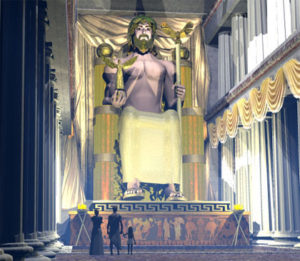
However, the athletes would stay for 1 or 2 months before the games in Olympia to train in the Palaestra. Before the games, the high priestess of Olympia marked the beginning of the games lighting the Olympic flame. Also, offerings and ceremonies in the temple of Zeus and the temple of Hera were practiced to ask for the favor of the gods. The games would take place in the stadium and people would watch them from the hills around it. All athletes were male and would take part in the games in total nudity. Women were forbidden under the penalty of death to part take in the games or even watch them as a spectator. The only woman who could watch the games, and in fact from a privileged spot, was the priestess of the temple of Demeter in Olympia.
There were no seats for the spectators and all people regardless of their social state would sit on the ground. The Hellanodikae, a body of priests, were responsible to name the winners. The reward of the winning athletes was a crown made from a wild olive tree, which was enough to honor him, his family and his city for decades. In fact, it was such an honor to be an Olympic winner that their town even pulled down a part of their city walls, as the town would be protected by the winner. At the same time, the political personalities from different parts of Greece took advantage of the games to make speeches and try to resolve differences against each other. The games were also a good opportunity for traders to make business deals. Unfortunately, in 393 AD, the Olympic Games were suspended by the Byzantine Emperor Theodosius, as it was considered a pagan custom. It was the time when Christianity was the dominant religion of the Byzantine Empire and everything connected to the ancient Greek spirit was considered pagan. Thus the games were stopped, the temples of Olympia were turned into churches and important statues, among which the golden statue of Zeus, a miracle of the ancient world, was transferred to Constantinople.
The revival of the Olympic Games in the modern era was an idea of the French Baron Pierre de Coubertin, who founded the International Olympic Committee in 1894 and only two years later, in 1896, the first modern Olympic Games took place in Athens, at the renovated Panathenaic Stadium. Since then, the games take place every 4 years in a different place in the world every time.
Nafpaktos:
The name Nafpaktos derives from nafs which means boat in ancient Greek. The privileged location of Nafpaktos not only benefited the ship building activity but located so close to the Peloponnese made it a nice spot to have control over the western side of the Corinthian bay. During the Peloponnesian War in 455 BC, Nafpaktos became a chief naval station. In Medieval times, in spite of the many earthquakes, it also worked as one of the most important ports in the area, as it served as a connection between Europe and the Holy Land. Nafpaktos also became one of the most important ports of the Byzantine fleet and it was used as a proper station for diplomatic communications to the West and at the same time to Constantinople. Then, in 1204, Nafpaktos was captured by the Venetians and was recorded as Lepanto on their documents, a name that became very famous after the Battle of Lepanto, an important point in the history of Nafpaktos. In the 13th century, the city was ceded to Michael Doukas Komnenos. During this same century, he offered Nafpaktos to Philip of Taras, the fiance of his daughter as a marriage dowry. The following century, the control of the city passed to the Ottomans. In 1407, Nafpaktos fell under the Venetians again who repaired the old Byzantine walls and fortified the port with a strong castle in order to create a safe station. The Ottomans finally invaded the city in 1499. In October of 1571, the legendary Battle of Lepanto took place between the Ottomans and Europeans, leading to the victory of the Europeans. According to historians, this battle marked the decline of the Ottoman Empire. Among the soldiers to participate in this fight was Miguel de Cervantes, the famous writer who was fighting in the Spanish fleet that time and in fact, he lost his left arm in the battle. His statue is found today at the port of Nafpaktos. Many fights followed to set the town free. Nafpaktos had an important contribution to the Greek War of Independence and many heroes operated there in fact, the statue of Anemogiannis, a Freedom fighter, stands today at the port of Nafpaktos. Finally, in 1829, Nafpaktos earned its freedom and became part of the first Greek State.
Delphi:
Delphi was an important ancient Greek religious sanctuary sacred to the god Apollo. Located on Mt. Parnassus near the Gulf of Corinth, the sanctuary was home to the famous oracle of Apollo which gave cryptic predictions and guidance to both city-states and individuals. In addition, Delphi was also home to the PanHellenic Pythian Games.
MYTHOLOGY & ORIGINS:
The site was first settled in Mycenaean times in the late Bronze Age (1500-1100 BCE) but took on its religious significance from around 800 BCE. The original name of the sanctuary was Pytho after the snake which Apollo was believed to have killed there. Οfferings at the site from this period include small clay statues (the earliest), bronze figurines, and richly decorated bronze tripods.
Delphi was also considered the center of the world, for in Greek mythology Zeus released two eagles, one to the east and another to the west, and Delphi was the point at which they met after encircling the world. This fact was represented by the omphalos (or navel); a dome-shaped stone that stood outside Apollo’s temple and which also marked the spot where Apollo killed the Python.
APOLLO’S ORACLE:
The oracle of Apollo at Delphi was famed throughout the Greek world and even beyond. The oracle – the Pythia or priestess – would answer questions put to her by visitors wishing to be guided in their future actions. The whole process was a lengthy one, usually taking up a whole day and only carried out on specific days of the year. First, the priestess would perform various actions of purification such as washing in the nearby Castalian Spring, burning laurel leaves and drinking holy water. Next an animal – usually a goat – was sacrificed. The party seeking advice would then offer a pelanos – a sort of pie – before being allowed into the inner temple where the priestess resided and gave her pronouncements, possibly in a drug or natural gas-induced state of ecstasy.
Perhaps the most famous consultant of the Delphic oracle was Croesus, the fabulously rich King of Lydia who, when faced with a war against the Persians, asked the oracle’s advice. The oracle stated that if Croesus went to war then a great empire would surely fall. Reassured by this, the king took on the mighty Cyrus. However, the Lydians were overpowered at Sardis and it was the Lydian empire which fell, a lesson that the oracle could easily be misinterpreted by the unwise or over-confident.
PANHELLENIC GAMES:
Delphi, as with the other major religious sites of Olympia, Nemea, and Isthmia, held games to honor various gods of the Greek religion. The Pythian Games of Delphi began sometime between 591 and 585 BCE and were initially held every eight years, with the only event being a musical competition where solo singers accompanied themselves on a kithara to sing a hymn to Apollo. Later, more musical contests and athletic events were added to the program, and the games were held every four years with only the Olympic Games being more important. The principal prize for victors in the Games was a crown of laurel or bay leaves.
The site and games were managed by the independent Delphic amphictiony – a council with representatives from various nearby city-states – which asked for taxes, collected offerings, invested in construction programs, and even organized military campaigns in the Four Sacred Wars, fought to remedy sacrilegious acts against Apollo committed by the states of Crisa, Phocis, and Amphissa.
ARCHITECTURE :
The first temple in the area was built in the 7th century BCE and was a replacement for less substantial buildings of worship which had stood before it. The focal point of the sanctuary, the Doric temple of Apollo, was unfortunately destroyed by fire in 548 BCE. A second temple, again Doric in style, was completed in 510 BCE. Measuring some 60 by 24 meters, the facade had six columns whilst the sides had 15. This temple was destroyed by an earthquake in 373 BCE and was replaced by a similarly sized temple in 330 BCE. This was constructed with porous stone coated in stucco. Marble sculpture was also added as decoration along with Persian shields taken at the Battle of Marathon. This is the temple that survives, although only partially, today.
Other notable constructions were the theatre (with capacity for 5,000 spectators), temples to Athena (4th century BCE), a tholos with 13 Doric columns ( 580 BCE), stoas, a stadium (with capacity for 7,000 spectators), and around 20 treasuries, which were constructed to house the votive offerings and dedications from city-states all over Greece. Similarly, monuments were also erected to commemorate military victories and other important events. For example, the Spartan general Lysander erected a monument to celebrate his victory over Athens at Aegospotami. Other notable monuments were the great bronze Bull of Corcyra (580 BCE), the ten statues of the kings of Argos (369 BCE), a gold four-horse chariot offered by Rhodes, and a huge bronze statue of the Trojan Horse offered by the Argives (413 BCE). Lining the sacred way, from the sanctuary gate up to the temple of Apollo, the visitor must have been greatly impressed by the artistic and literal wealth on display. Alas, in most cases, only the monumental pedestals survive of these great statues, silent witnesses to lost grandeur.
DEMISE: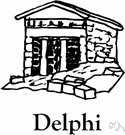
In 480 BCE the Persians attacked the sanctuary and in 279 BCE the sanctuary was attacked again, this time by the Gauls. During the 3rd century BCE, the site came under the control of the Aitolian League. In 191 BCE Delphi passed into Roman hands; however, the sanctuary and the games continued to be culturally important in Roman times, in particular under Hadrian. The decree by Theodosius in 393 CE to close all pagan sanctuaries resulted in Delphi’s gradual decline. A Christian community dwelt at the site for several centuries until its final abandonment in the 7th century CE.
The site was ‘rediscovered’ with the first modern excavations being carried out in 1880 CE by a team of French archaeologists. Notable finds were splendid metope sculptures from the treasury of the Athenians (490 BCE) and the Siphnians (525 BCE) depicting scenes from Greek mythology. In addition, a bronze charioteer in the severe style (480-460 BCE), the marble Sphinx of the Naxians (560 BCE), the twin marble archaic statues – the kouroi of Argos (580 BCE) and the richly decorated omphalos stone (330 BCE) – all survive as testimony to the cultural and artistic wealth that Delphi had once enjoyed.
Hosios Loukas:
The World Heritage-listed monastery, Moni Hosios Loukas, is 23 km southeast of Arahova, between the villages of Distomo and Kyriaki. The monastic complex includes two churches. Its principal church contains some of Greece’s finest Byzantine frescoes. Modest dress is required (no shorts). Nearby is the smaller 10th-century Agia Panagia (Church of the Virgin Mary). The monastery is dedicated to a local hermit who was canonized for his healing and prophetic powers
The interior of the larger church, Agios Loukas, is a glorious symphony of marble and mosaics, with icons by Michael Damaskinos, the 16th-century Cretan painter. In the main body of the church, the light is partially blocked by the ornate marble window decorations, creating striking contrasts of light and shade. Walk around the corner to find several fine frescoes that brighten up the crypt where St Luke is buried.
Cancellation Policy

All cancellations must be confirmed by Olive Sea Travel.
Regarding the Multiple Day Tours:
Cancellations up to 30 Days before your service date are 100% refundable.
Cancellation Policy:
- Licensed Tour Guides and Hotels are external co-operators & they have their own cancellation policy.
- Apart from the above cancellation limits, NO refunds will be made. If though, you fail to make your appointment for reasons that are out of your hands, that would be, in connection with the operation of your airline or cruise ship or strikes, extreme weather conditions or mechanical failure, you will be refunded 100% of the paid amount.
- If your cancellation date is over TWO (2) months away from your reservation date, It has been known for third-party providers such as credit card companies, PayPal, etc. to charge a levy fee usually somewhere between 2-4%.
- Olive Sea Travel reserves the right to cancel your booking at any time, when reasons beyond our control arise, such as strikes, prevailing weather conditions, mechanical failures, etc. occur. In this unfortunate case, you shall be immediately notified via the email address you used when making your reservation and your payment WILL be refunded 100%.
Recommended for you


